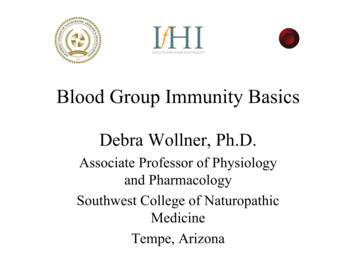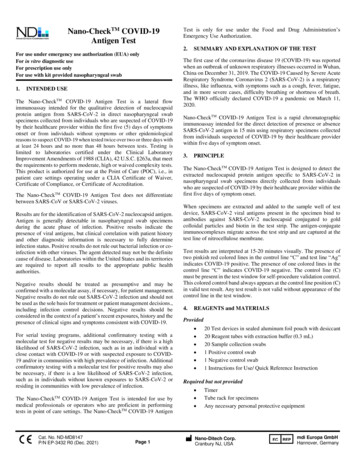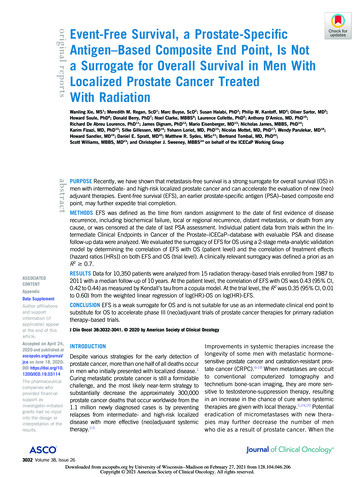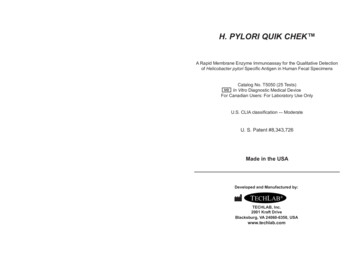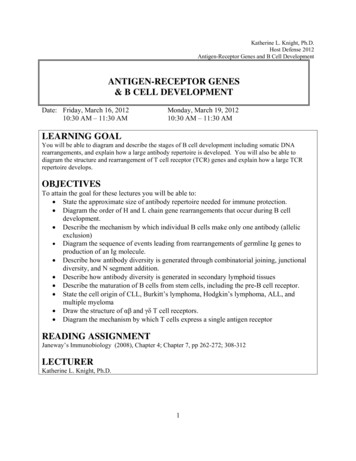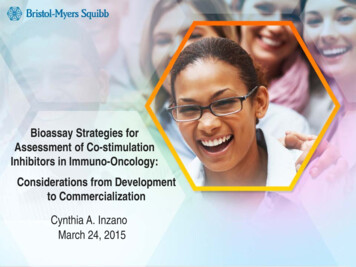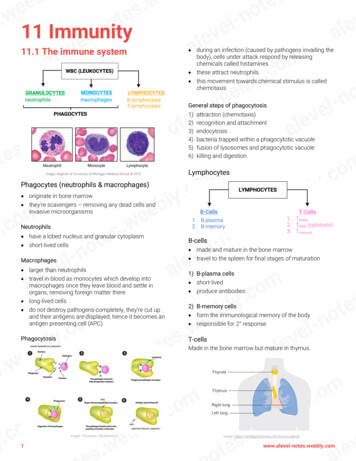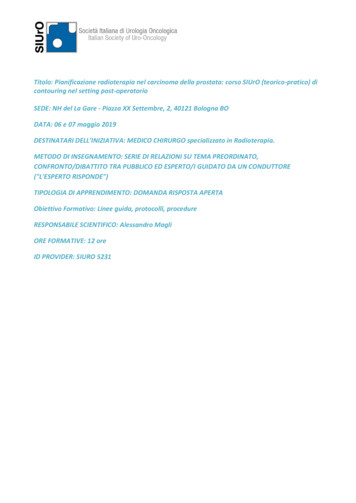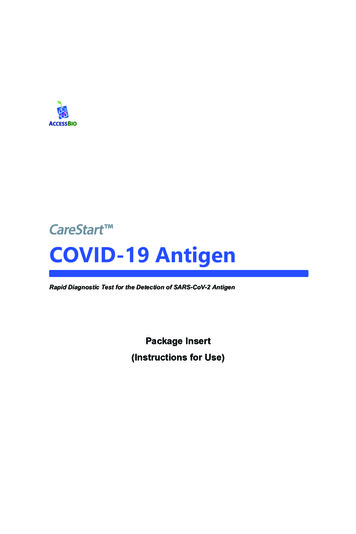
Transcription
For use under the Emergency Use Authorization (EUA) onlyFor in vitro diagnostic use onlyFor prescription use onlyCOVID-19 AntigenRapid Diagnostic Test for the Detection of SARS-CoV-2 AntigenPackage Insert(Instructions for Use)
RCHM-02071CareStartTM COVID-19 AntigenRapid Diagnostic Test for Detection of SARS-CoV-2 AntigenTable of ContentsIntended Use .3Summary and Explanation of the Test.3Principles of the Test.4Reagents and Materials Provided .4Warnings and Precautions .5Storage and Stability .6Quality Control .6Specimen Collection and Handling .6Test Procedures .8Interpretation of Results . 10Limitations. 10CONDITIONS of AUTHORIZATION for LABORATORY . 11Performance Characteristics . 13High-dose Hook Effect . 17Point of Care Use . 17Technical Support . 17IFU-RCHM71-E / Rev. AACCESS BIO, INC.Page 2 of 18
RCHM-02071CareStartTM COVID-19 AntigenRapid Diagnostic Test for Detection of SARS-CoV-2 AntigenFor use under the Emergency Use Authorization (EUA) onlyFor in vitro diagnostic use onlyFor prescription use onlyIntended UseThe CareStart COVID-19 Antigen test is a lateral flow immunochromatographic assayintended for the qualitative detection of the nucleocapsid protein antigen from SARS-CoV-2 innasopharyngeal swab specimens directly collected, or collected in BD universal transport media,from individuals suspected of COVID-19 by their healthcare provider within five days of symptomonset. Testing is limited to laboratories certified under the Clinical Laboratory ImprovementAmendments of 1988 (CLIA), 42 U.S.C. §263a, that meet the requirements to perform moderate,high or waived complexity tests. This test is authorized for use at the Point of Care (POC), i.e.,in patient care settings operating under a CLIA Certificate of Waiver, Certificate of Compliance,or Certificate of Accreditation.Results are for the identification of the SARS-CoV-2 nucleocapsid protein antigen. The antigenis generally detectable in nasopharyngeal swab specimens during the acute phase of infection.Positive results indicate the presence of viral antigens, but the clinical correlation with patienthistory and other diagnostic information is necessary to determine infection status. Positiveresults do not rule out a bacterial infection or co-infection with other viruses. The agent detectedmay not be the definite cause of disease. Laboratories within the United States and its territoriesare required to report all results to the appropriate public health authorities.Negative results are presumptive and confirmation with a molecular assay, if necessary, forpatient management may be performed. Negative results do not rule out SARS-CoV-2 infectionand should not be used as the sole basis for treatment or patient management decisions,including infection control decisions. Negative results should be considered in the context of apatient’s recent exposures, history and the presence of clinical signs and symptoms consistentwith COVID-19.The CareStart COVID-19 Antigen is intended for use by medical professionals or trainedoperators who are proficient in performing tests and trained clinical laboratory personnel orindividuals trained in point of care settings. The CareStart COVID-19 Antigen is only for useunder the Food and Drug Administration’s Emergency Use Authorization.Summary and Explanation of the TestSince the first outbreak reported in December 2019, SARS-CoV-2 has spread rapidly worldwide,and the disease it causes has been named “Coronavirus Disease 2019” (COVID-19). Due to itshighly contagious nature and global health crises, SARS-CoV-2 has been designated as apandemic by the World Health Organization (WHO). SARS-CoV-2 continues to have devastatingIFU-RCHM71-E / Rev. AACCESS BIO, INC.Page 3 of 18
RCHM-02071CareStartTM COVID-19 AntigenRapid Diagnostic Test for Detection of SARS-CoV-2 Antigenimpacts on healthcare systems and the world economy including the U.S. To effectively end theSARS-CoV-2 pandemic, systematic screening and detection of both clinical and asymptomaticCOVID-19 cases is critical. Particularly, the identification of subclinical or asymptomatic casesis important to reduce or stop the infection because these individuals may transmit the virus. Asa point-of-care test with a 10 min testing time, CareStart COVID-19 Antigen test allowseffective screening of COVID-19 infection on a large scale.Principles of the TestThe CareStart COVID-19 Antigen test is a lateral flow immunochromatographic assay for thedetection of extracted nucleocapsid protein antigens specific to SARS-CoV-2 in nasopharyngealswab specimens either directly collected or collected in BD universal transport media fromindividuals who are suspected of COVID-19 by their healthcare provider within the first five daysof symptom onset.Nasopharyngeal swabs require a sample preparation step in which the sample is eluted into theextraction buffer solution. Extracted swab sample is added to the sample well of the test deviceto initiate the test. When the swab sample migrates in the test strip, SARS-CoV-2 viral antigensbind to anti-SARS-CoV-2 nucleocapsid protein antibodies conjugated to indicator and captureparticles in the test strip forming an immune complex. The immune complex is then captured bythe test line on the nitrocellulose membrane as it migrates through the strip.Test results are interpreted at 10 minutes. The presence of two colored lines in the control lineregion “C” and test line region “T” indicates COVID-19 positive. The presence of one coloredlines in the control line region “C” indicates COVID-19 negative. No appearance of a colored linein the control region “C” indicates an invalid test.Reagents and Materials ProvidedContents NameQuantity(in a kit)Test device20 eachNasopharyngeal swab20 vials andcaps20 eachPositive control swab1 eachNegative control swab1 eachExtraction vial / capIFU-RCHM71-E / Rev. ATimerFoil pouched test device containing one test strip whichis encased in plastic device cassette.The extraction vial contains 400 l extraction buffersolution.swabs for nasopharyngeal specimen collection.Recombinant SARS-CoV-2 nucleocapsid proteinantigen is dried on the foam-tipped head.Package insert1 eachQuick Reference Instructions (QRI)1 eachThe following materials are needed but not provided:Pair of glovesDescriptionBlank Universal Viral Transport media (BD UVT) isdried on the foam-tipped head.Instructions for useQuick reference instructionsBiohazard or sharps containerACCESS BIO, INC.MicropipettePage 4 of 18
RCHM-02071CareStartTM COVID-19 AntigenRapid Diagnostic Test for Detection of SARS-CoV-2 AntigenWarnings and PrecautionsFor prescription and in vitro diagnostic use only.This test has not been FDA cleared or approved.This test has not been FDA cleared or approved; the test has been authorized by FDA under anEmergency Use Authorization (EUA) for use by laboratories certified under the CLIA that meet therequirements to perform moderate, high or waived complexity tests. This test is authorized for useat the Point of Care (POC), i.e., in patient care settings operating under a CLIA Certificate of Waiver,Certificate of Compliance, or Certificate of Accreditation.This test is only authorized for the duration of the declaration that circumstances exist justifying theauthorization of emergency use of in vitro diagnostic tests for detection and/or diagnosis of COVID19 under Section 564(b)(1) of the Federal Food, Drug, and Cosmetic Act, 21 U.S.C. § 360bbb-3(b)(1),unless the authorization is terminated or revoked sooner.This test has been authorized only for the detection of proteins from SARS-CoV-2, not for any otherviruses or pathogens.As with all diagnostic tests, all results must be interpreted together with other clinical informationavailable to the physician.Immediately use after opening the test device in the pouch.In order to obtain accurate results, the test must follow this package insert.Excess blood or mucus on the swab specimen may interfere with test performance and may yield afalse-positive result. Avoid touching any bleeding areas of the nasopharynx when collectingspecimens.Do not interpret the test result before 10 minutes and after 15 minutes starting the test.Inadequate or inappropriate sample collection, storage, and transport can result in incorrect results.Ifspecimen storage is necessary, swabs can be placed into extraction buffer for up to four hours.Specimens should not be stored dry.Do not use if the test device package is damaged.Do not use the kit contents beyond the expiration date.Do not eat, drink, or smoke in the area where the specimens and kit contents are handled.Use appropriate precautions in the collection, handling, storage, and disposal of patient samples andused kit contents.Dispose of used contents as biohazardous wastes in accordance with federal, state, and localrequirements.Nitrile or latex gloves should be worn when performing this test.If the extraction buffer contacts the skin or eye, flush with copious amounts of water.Handle all specimens as though they contain infectious agents.Observe established precautions against microbiological hazards throughout the procedure andfollow the standard procedures for proper disposal of specimens.Reagents contain sodium azide, which is harmful if inhaled, swallowed, or exposed to skin. Contactwith acids produces a very toxic gas. If there is contact with skin, wash immediately with plenty ofwater. Sodium azide may react with lead and copper plumbing to form highly explosive metal azides.On disposal, flush with a large volume of water to prevent azide build-up.Do not interchange kit contents from different lots.Do not re-use any contents in the kit as they are single-use only.For additional information on hazard symbols, safety, handling and disposal of the componentswithin this kit, please refer to the Safety Data Sheet (SDS) located at accessbio.net.IFU-RCHM71-E / Rev. AACCESS BIO, INC.Page 5 of 18
RCHM-02071CareStartTM COVID-19 AntigenRapid Diagnostic Test for Detection of SARS-CoV-2 AntigenStorage and StabilityStore the test kit as packaged between 1 30 C.The reagents and materials in the CareStart COVID-19 Antigen are stable until theexpiration date printed on the outer packaging. Do not use beyond the expiration date.The test device must remain in the sealed pouch until use.Do not freeze any contents of the kit.Quality ControlInternal Quality Control: The CareStart COVID-19 Antigen contains a built-in internalprocedural control that is included in the test device. A red-colored line appearing in the controlregion “C” is designed as an internal procedural control. The appearance of the proceduralcontrol line indicates that sufficient flow has occurred, and the functional integrity of the testdevice has been maintained. If the procedural control line does not develop in 10 minutes, thetest result is considered invalid and retesting with a new device is recommended. If the internalprocedural control line is still absent in the retest, please contact the Technical Support at 1888-898-1270 (Available Hours: Mon. to Fri.: 8 a.m. – 5 p.m.) or TShelp@accessbio.net (24/7available).External Control: External control is used to demonstrate that the test device and testprocedure perform properly. It is recommended that positive and negative external controlswabs are run once with every new lot, shipment, and each new user. External positive andnegative control swabs are provided in the kit. The external control should be tested using thenasopharyngeal swab test procedure provided in this package insert or the quick referenceinstruction card. If the external control results are invalid, please contact the Technical Supportat 1-888-898-1270 (Available Hours: Mon. to Fri.: 8 a.m. – 5 p.m.) or TShelp@accessbio.net(24/7 available) before testing patient specimens.Specimen Collection and HandlingAcceptable specimen type for testing with the CareStart COVID-19 Antigen is a directnasopharyngeal swab specimen or a swab in BD universal transport media. It is essential thatcorrect specimen collection and preparation methods be followed. Inadequate specimencollection, improper specimen handling and/or transport may yield false results; therefore,specimen collection requires specific training and guidance due to the importance of specimenquality to obtain accurate test results. Specimens may be frozen at -80C and used up to 5 daysand are stable for 4 hours in extraction buffer. Refer to the CDC Interim Guidelines for Collecting,Handling, and Testing Clinical Specimens from Persons for Coronavirus Disease 2019 (COVID19) elines-clinical-specimens.htmlIFU-RCHM71-E / Rev. AACCESS BIO, INC.Page 6 of 18
RCHM-02071CareStartTM COVID-19 AntigenRapid Diagnostic Test for Detection of SARS-CoV-2 AntigenNasopharyngeal Swab Sample Collection ProcedureProcedural NotesProcess the test sample immediately after collection.Use only provided or recommended nasopharyngeal swab for specimen collection.Collect the specimen wearing safety gloves to avoid contamination.Do not touch the tip (specimen collection area) of the swab.Collect samples as soon as possible after the onset of symptoms.1. Remove a nasopharyngeal swabfrom the pouch.2. Place the swab into one of thepatient’s nostrils until it reaches theposterior nasopharynx; keep insertuntil resistance is encountered orthe distance is equivalent to thatfrom the ear to the nostril of thepatient.3. Slowly rotate 3-5 times the swabover the surface of the posteriornasopharynx.4. Slowly remove the swab from thenostril while rotating it.IFU-RCHM71-E / Rev. AACCESS BIO, INC.Page 7 of 18
RCHM-02071CareStartTM COVID-19 AntigenRapid Diagnostic Test for Detection of SARS-CoV-2 AntigenTest ProceduresProcedural NotesAllow test devices, reagents, specimens, and/or controls to equilibrate to roomtemperature (15 30 C) prior to testing.Remove the CareStart COVID-19 Antigen test device and extraction vial from its foilpouch immediately before testing.The CareStart COVID-19 Antigen kit IS INTENDED to be used only with a directnasopharyngeal swab specimen or a swab in BD universal transport media.The CareStart COVID-19 Antigen kit IS NOT INTENDED for testing other liquidsamples such as nasal wash or aspirate samples as results can be compromised by overdilution.Direct Nasopharyngeal Swab Test Procedure1. Peel off aluminum foil seal from thetop of the extraction vial containing theextraction bufferIFU-RCHM71-E / Rev. A2. Place the swab into the extraction vial.Rotate the swab vigorously at least 5times.ACCESS BIO, INC.Page 8 of 18
RCHM-02071CareStartTM COVID-19 AntigenRapid Diagnostic Test for Detection of SARS-CoV-2 Antigen3. Remove the swab by rotating againstthe extraction vial while squeezing thesides of the vial to release the liquidfrom the swab. Properly discard theswab.4. Close the vial with the provided capand push firmly onto the vial.5. Mix thoroughly by flicking the bottomof the tube.6. Invert the extraction vial and hold thesample vertically above the samplewell. Squeeze the vial gently. Allowthree (3) drops of sample to fall intothe sample well. 2 drops of the sampleare required minimum volume toinitiate the test run and invalid resultswill be obtained if 1 drop of sample isadded to the cassette. Leakage of thesample is possible when 6 drops ormore of the sample are added.7. Read and interpret the test result at 10minutes. The test result should not beread and interpreted after 15 minutes.Nasopharyngeal Swab in Viral Transport Media (VTM) Test ProcedureNOTE: Only BD universal transport media have been validated with the assay.1. Mix the specimen stored in VTM by vortexing.2. Collect 400 µl of swab specimen with a calibrated micropipette from the VTM tube.IFU-RCHM71-E / Rev. AACCESS BIO, INC.Page 9 of 18
RCHM-02071CareStartTM COVID-19 AntigenRapid Diagnostic Test for Detection of SARS-CoV-2 AntigenNOTE: Avoid mucoid substances when collecting from the VTM tube.3. Add all 400 µl of collected swab specimen from the micropipette into the extraction vialafter peel off the aluminum foil seal.4. Follow Steps 4 – 7 of the Direct Nasopharyngeal Swab Test Procedure above.Interpretation of ResultsNOTE: The test results should be read and interpreted at 10 minutes after the sampleapplication and the reading and interpretation of the results should not exceed 15 minutes.The test results should not be interpreted using any instruments.Positive: two distinct colored lines appear.One red-colored line next to “C” and one blue-coloredline next to “T” indicates COVID-19 positive result.NOTE: The color intensity in the test region will vary depending on the amountof SARS-CoV-2 nucleocapsid protein antigen present in the sample. Any faintcolored line(s) in the test region(s) should be considered as positive.Negative:One red-colored line only next to “C” indicates a negativeresult.Invalid:If the red-colored line in the control region “C” is notvisible, the result is invalid. Re-run the test one time usingthe remaining specimen in the extraction vial if an invalidresult is obtained during initial testing.Limitations1. False negative results may occur in patients who have indicated or whose clinical status orhistory would indicate they are currently taking high doses of biotin ( 10 mg per day). Biotinlevels of 2.5 µg/mL have been demonstrated to result in false negative test results.2. Negative results, should be treated as presumptive and confirmation with a molecular assay,if necessary for patient management, may be performed.IFU-RCHM71-E / Rev. AACCESS BIO, INC.Page 10 of 18
RCHM-02071CareStartTM COVID-19 AntigenRapid Diagnostic Test for Detection of SARS-CoV-2 Antigen3. Failure to follow the instructions for use may adversely affect test performance and/orinvalidate the test result.4. If the differentiation of specific SARS viruses and strains is needed, additional testing, inconsultation with state or local public health departments, is required.5. Clinical performance using VTM was established on frozen specimens and performance maybe different with fresh clinical specimens.6. Extracted specimens may be frozen at -80 C and used up to 5 days after freezing and it arestable for 4 hours in extraction buffer at room temperature.7. Results from antigen testing should not be used as the sole basis to diagnose or excludeSARS-CoV-2 infection or to determine infection status.8. This test will indicate the presence of SARS-CoV-2 nucleocapsid protein antigen in thespecimen from both viable and non-viable SARS-CoV-2 virus. Test performance depends onthe amount of virus (antigen) in the sample and may or may not correlate with viral cultureresults performed on the same sample.9. The detection of SARS-CoV-2 nucleocapsid antigen is dependent upon proper specimencollection, handling, storage, and preparation. Failure to observe proper procedures in anyone of these steps can lead to incorrect results.10. Results from the device should be correlated with the clinical history, epidemiological dataand other data available to the clinician evaluating the patient.11. This device has been evaluated for use with human specimen material only.12. False-negative results may occur if the concentration of the target antigen in the clinicalspecimen is below the detection limits of the device.13. This device is a qualitative test and does not provide information on the viral concentrationpresent in the specimen.14. This test cannot rule out diseases caused by other bacterial or viral pathogens.15. The prevalence of infection will affect the test’s predictive values.16. Positive and negative predictive values are highly dependent on prevalence. False-negativetest results are more likely during peak activity when the prevalence of the disease is high.False-positive test results are more likely during the periods of low SARS-CoV-2 activitywhen prevalence is moderate to low.CONDITIONS of AUTHORIZATION for LABORATORYThe CareStart COVID-19 Antigen test Letter of Authorization, along with the authorized FactSheet for Healthcare Providers, the authorized Fact Sheet for Patients, and authorized labelingare available on the FDA website: dical-devices/vitro-diagnostics-euas.IFU-RCHM71-E / Rev. AACCESS BIO, INC.Page 11 of 18
RCHM-02071CareStartTM COVID-19 AntigenRapid Diagnostic Test for Detection of SARS-CoV-2 AntigenHowever, to assist clinical laboratories using the CareStart COVID-19 Antigen test (“yourproduct” in the conditions below), the relevant Conditions of Authorization are listed below:A. Authorized laboratories1 using your product will include with test result reports, allauthorized Fact Sheets. Under exigent circumstances, other appropriate methods fordisseminating these Fact Sheets may be used, which may include mass media.B. Authorized laboratories using your product will use your product as outlined in theauthorized labeling. Deviations from the authorized procedures, including theauthorized instruments, authorized extraction methods, authorized clinical specimentypes, authorized control materials, authorized other ancillary reagents and authorizedmaterials required to use your product are not permitted.C. Authorized laboratories that receive your product will notify the relevant public healthauthorities of their intent to run your product prior to initiating testing.D. Authorized laboratories using your product will have a process in place for reporting testresults to healthcare providers and relevant public health authorities, as appropriate.E. Authorized laboratories will collect information on the performance of your product andreport to DMD/OHT7-OIR/OPEQ/CDRH (via email: CDRH-EUAReporting@fda.hhs.gov) and ACCESS BIO, INC. (Technical Support at 1-888-8981270 or TShelp@accessbio.net) any suspected occurrence of false positive or falsenegative results and significant deviations from the established performancecharacteristics of your product of which they become aware.F. All operators using your product must be appropriately trained in performing andinterpreting the results of your product, use appropriate personal protective equipmentwhen handling this kit, and use your product in accordance with the authorized labeling.G. ACCESS BIO, INC., authorized distributors, and authorized laboratories using yourproduct will ensure that any records associated with this EUA are maintained untilotherwise notified by FDA. Such records will be made available to FDA for inspectionupon request.1 The letter of authorization refers to, “Laboratories certified under the Clinical Laboratory ImprovementAmendments of 1988 (CLIA), 42 U.S.C. §263a, that meet the requirements to perform moderate, high or waivedcomplexity tests. This test is authorized for use at the Point of Care (POC), i.e., in patient care settings operatingunder a CLIA Certificate of Waiver, Certificate of Compliance, or Certificate of Accreditation” as “authorizedlaboratories.”IFU-RCHM71-E / Rev. AACCESS BIO, INC.Page 12 of 18
RCHM-02071CareStartTM COVID-19 AntigenRapid Diagnostic Test for Detection of SARS-CoV-2 AntigenPerformance CharacteristicsClinical PerformanceTo initially evaluate the clinical performance of the CareStart COVID-19 Antigen test, a totalof 126 blinded frozen swab samples, including 106 retrospective clinical specimens and 20contrived specimens, were tested in one (1) CLIA waived investigational site by five (5) minimallytrained operators in the U.S during the 2020 COVID-19 season.A total of 126 frozen samples consisting of 43 positive nasopharyngeal (NP) swabs, 63 negativeNP swab specimens, and 20 contrived near the cut-off samples (10 positives and 10 negatives).NP swab specimens collected from the patients with COVID-19 like symptoms in the U.S duringthe 2020 COVID-19 season and stored in BD universal transport media tube were provided bymultiple vendors in the U.S. All the NP swab specimens were confirmed as positive or negativeand validated with Ct value by the FDA EUA RT-PCR as a comparator method prior to the study.The specimens were aliquoted, randomized, and blinded into sample panels that was tested byeach operator, using the instructions provided by the Quick Reference Instructions (QRI).In addition to the clinical population, a total of 20 contrived near the cut-off samples, 10 lowpositives near the Limit of Detection (LoD) (2x LoD), and 10 negatives (zero analytes) samples,were prepared using the inactivated SARS-CoV-2 strain spiked into the simulated nasal swabmatrix, BD universal transport media. The heat-inactivated SARS-CoV-2 isolate USA-WA1/2020was used to prepare the positive samples. The contrived near the cut-off samples were addedto the clinical population and tested at the same study site by the same operators. All the studysamples were randomized and assigned with unique study subject ID by the sponsor prior totesting at the study site. The expected results of the samples were completely blinded to theoperators. All the samples were tested by five (5) operators according to the Quick ReferenceInstructions only.A total of 126 frozen swab samples were considered evaluable in this study. The performanceof the CareStart COVID-19 Antigen as compared to the RT-PCR comparator method arepresented in the table below:CareStart COVID-19 Antigen (retrospective samples) Performance against theComparator MethodCareStart COVID-19 AntigenPositiveNegativeTotalPositive Percent Agreement (PPA)Negative Percent Agreement (NPA)IFU-RCHM71-E / Rev. 8.37% (95% CI: 75.52% – 94.93%)100% (95% CI: 94.25% – 100%)ACCESS BIO, INC.Page 13 of 18
RCHM-02071CareStartTM COVID-19 AntigenRapid Diagnostic Test for Detection of SARS-CoV-2 AntigenPatient DemographicsYears of Age6-21 Years of Age22-59 Years of AgeYears of AgeTotal #195837CareStart COVID-19 03%Unknown11100%Age GroupCareStart COVID-19 Antigen (near the cut-off samples) PerformanceSample categoryOverall % Agreement (result count)True negative (zero analytes)100.0% (10/10)Low positive (2x LoD)100.0% (10/10)Prospective Clinical StudyThe clinical performance characteristics of CareStart COVID-19 Antigen test is currently beingevaluated in a multi-site prospective study in the U.S in which NP swabs from patients aresequentially enrolled and tested. A total of five (5) investigational sites throughout the U.S areparticipating in the study. Testing is performed by operators with no laboratory experience andwho are representative of the intended users. Operators are only using the QRI for the testwithout any training provided. The patients presenting the COVID-19 like symptoms within five(5) days of symptom onset at the study sites are enrolled. An FDA EUA RT-PCR assay for thedetection of SARS-CoV-2 from a NP or nasal swab is utilized as the comparator method for thestudy. The initial six (6) positive patient results are presented as below.CareStart COVID-19 Antigen Initial Performance against the Comparator 83.33% (95% CI: 43.65% – 97.00%)CareStart COVID-19 AntigenPositiveNegativeTotalPositive Percent Agreement (PPA)Negative Percent Agreement (NPA)100% (95% CI: 81.57% – 100%)Patient DemographicsAge GroupYears of Age6-21 Years of AgeIFU-RCHM71-E / Rev. ATotal #06CareStart COVID-19 AntigenPositive03ACCESS BIO, INC.PrevalenceN/A50.00%Page 14 of 18
RCHM-02071CareStartTM COVID-19 Antigen22-59 Years of AgeYears of AgeRapid Diagnostic Test for Detection of SARS-CoV-2 Antigen12216.67%5120.00%Analytical Sensitivity: Limit of Detection (LoD)The LoD for direct swab was established using heat-inactivated SARS-CoV-2 isolate USAWA1/2020 (NR-52286). The strain was spiked into the pooled human nasal sw
RCHM-02071 CareStartTM COVID-19 Antigen Rapid Diagnostic Test for Detection of SARS-CoV-2 Antigen IFU-RCHM71-E/ Rev.A ACCESS BIO, INC. Page 6of 18 Storage and Stability x Store the test kit as packaged between 1 30 C. x The reagents and materials in the CareStart COVID-19 Antigen are stable until the expiration date printed on the outer packaging.

